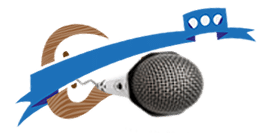John F Kennedy (1917-1963)
John F Kennedy (1917-1963) was an American statesman who served as the 35th President of the United States from January 1961 until his assassination in November 1963. Kennedy served at the height of the Cold War, and much of his presidency focused on managing relations with the Soviet Union. He was a member of the Democratic Party who represented Massachusetts in the United States House of Representatives and the United States Senate prior to becoming president.
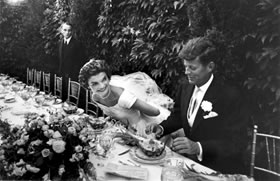 Kennedy was born in Brookline, Massachusetts, to Joseph P. Kennedy, Sr. and Rose Kennedy. A scion of the Kennedy family, he graduated from Harvard University in 1940 before joining the United States Naval Reserve the following year. During World War II, Kennedy commanded a series of PT boats in the Pacific theater and earned the Navy and Marine Corps Medal for his service. After the war, Kennedy represented Massachusetts’s 11th congressional district in the United States House of Representatives from 1947 until 1953. He was subsequently elected to the U.S. Senate and served as the junior Senator from Massachusetts from 1953 until 1960. While serving in the Senate, he published Profiles in Courage, which won the Pulitzer Prize for Biography. In the 1960 presidential election, Kennedy narrowly defeated Republican opponent Richard Nixon, who was the incumbent Vice President.
Kennedy was born in Brookline, Massachusetts, to Joseph P. Kennedy, Sr. and Rose Kennedy. A scion of the Kennedy family, he graduated from Harvard University in 1940 before joining the United States Naval Reserve the following year. During World War II, Kennedy commanded a series of PT boats in the Pacific theater and earned the Navy and Marine Corps Medal for his service. After the war, Kennedy represented Massachusetts’s 11th congressional district in the United States House of Representatives from 1947 until 1953. He was subsequently elected to the U.S. Senate and served as the junior Senator from Massachusetts from 1953 until 1960. While serving in the Senate, he published Profiles in Courage, which won the Pulitzer Prize for Biography. In the 1960 presidential election, Kennedy narrowly defeated Republican opponent Richard Nixon, who was the incumbent Vice President.
Kennedy’s time in office was marked by high tensions with Communist states in the Cold War. He increased the number of American military advisers in South Vietnam by a factor of 18 over President Dwight D. Eisenhower. In April 1961, he authorized a failed joint-CIA attempt to overthrow the Cuban government of Fidel Castro in the Bay of Pigs Invasion.
He subsequently rejected plans by the Joint Chiefs of Staff to orchestrate false-flag attacks on American soil in order to gain public approval for a war against Cuba. In October 1962, U.S. spy planes discovered that Soviet missile bases had been deployed in Cuba; the resulting period of tensions, termed the Cuban Missile Crisis, nearly resulted in the breakout of a global thermonuclear conflict. Domestically, Kennedy presided over the establishment of the Peace Corps and supported the Civil Rights Movement, but he was largely unsuccessful in passing his New Frontier domestic policies. Kennedy continues to rank highly in historians’ polls of U.S. presidents and with the general public. His average approval rating of 70% is the highest of any president in Gallup’s history of systematically measuring job approval.
On November 22, 1963, Kennedy was assassinated in Dallas, Texas. Lee Harvey Oswald was arrested for the crime, but he was never prosecuted due to his murder by Jack Ruby two days later. Pursuant to the Presidential Succession Act, Vice President Lyndon B. Johnson was sworn in as president later that day. The FBI and the Warren Commission officially concluded that Oswald was the lone assassin, but various groups believed that Kennedy was the victim of a conspiracy. After Kennedy’s death, many of his proposals were enacted, including the Civil Rights Act of 1964 and the Revenue Act of 1964.
Jackie Kennedy / A Tour of the White house
A Tour of the White house Was a television special featuring the First Lady of the United States, Jacqueline Kennedy on a tour of the recently renovated White House. It was broadcast on Valentine’s Day, February 14, 1962, on both CBS and NBC, and broadcast four days later on ABC.
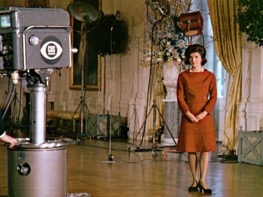 The program was the first ever First Lady televised tour of the White House, and has since been considered the first prime-time documentary specifically designed to appeal to a female audience.
The program was the first ever First Lady televised tour of the White House, and has since been considered the first prime-time documentary specifically designed to appeal to a female audience.
The film showed Kennedy on a tour of the house with the CBS News correspondent Charles Collingwood. The filmed tour was the first glimpse the American public had had of the $2 million restoration of the White House that Kennedy had helped direct in the first year of her husband’s presidency
The First Family
The First Family is a comedy album recorded on October 22, 1962, as a good-natured parody of President John F. Kennedy, both as Commander-in-Chief and as a member of a large, well-known political family.
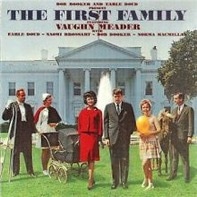 Issued by Cadence Records, it was honored as the “largest and fastest selling record in the history of the record industry” selling at more than a million copies per week for the first six and one-half weeks in distribution, by January it had sold more than 7 million copies. Cadence president Archie Bleyer credited the album’s success to radio airplay. By time of the release of The First Family – Volume Two, the sequel, it had sold 7.5 million copies — unprecedented for any album at the time, let alone a comedy album.
Issued by Cadence Records, it was honored as the “largest and fastest selling record in the history of the record industry” selling at more than a million copies per week for the first six and one-half weeks in distribution, by January it had sold more than 7 million copies. Cadence president Archie Bleyer credited the album’s success to radio airplay. By time of the release of The First Family – Volume Two, the sequel, it had sold 7.5 million copies — unprecedented for any album at the time, let alone a comedy album.
Project Mercury: Friendship 7, John Glenn
Project Mercury: Friendship 7, John Glenn Was the third human spaceflight for the U.S. and part of Project Mercury. Conducted by NASA on February 20, 1962, the mission was piloted by astronaut John Glenn, who performed three orbits of the Earth, making him the first U.S. astronaut to orbit the Earth.
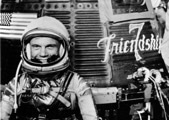 After a long series of delays, Friendship 7 lifted off from Cape Canaveral Air Force Station on February 20, 1962. There were eleven delays during the countdown due to equipment malfunctions, improvements to equipment functioning properly and the weather. During Glenn’s first orbit, a failure of the automatic-control system was detected. This forced Glenn to operate in manual mode for the second and third orbits, and for re-entry. Later in the flight, telemetry indicated that the heat shield had loosened. If this reading were accurate, Glenn and his spacecraft would burn up on re-entry. After a lengthy discussion on how to deal with this problem, ground controllers decided that leaving the solid-fueled retrorocket pack in place might help keep the loose heat shield in place. They relayed these instructions to Glenn, but did not tell him that the heat shield was possibly loose; although confused at this order, he complied. Leaving the retrorocket pack on made large chunks of flaming debris fly past the window of his capsule during re-entry, which Glenn thought it might have been the heat shield. He told an interviewer, “Fortunately it was the rocket pack—or I wouldn’t be answering these questions.”[85] After the flight, it was determined that the heat shield was not loose, but rather that the sensor was faulty.
After a long series of delays, Friendship 7 lifted off from Cape Canaveral Air Force Station on February 20, 1962. There were eleven delays during the countdown due to equipment malfunctions, improvements to equipment functioning properly and the weather. During Glenn’s first orbit, a failure of the automatic-control system was detected. This forced Glenn to operate in manual mode for the second and third orbits, and for re-entry. Later in the flight, telemetry indicated that the heat shield had loosened. If this reading were accurate, Glenn and his spacecraft would burn up on re-entry. After a lengthy discussion on how to deal with this problem, ground controllers decided that leaving the solid-fueled retrorocket pack in place might help keep the loose heat shield in place. They relayed these instructions to Glenn, but did not tell him that the heat shield was possibly loose; although confused at this order, he complied. Leaving the retrorocket pack on made large chunks of flaming debris fly past the window of his capsule during re-entry, which Glenn thought it might have been the heat shield. He told an interviewer, “Fortunately it was the rocket pack—or I wouldn’t be answering these questions.”[85] After the flight, it was determined that the heat shield was not loose, but rather that the sensor was faulty.
Friendship 7 safely splashed down 800 miles (1,290 km) southeast of Cape Canaveral after Glenn’s 4-hour, 55-minute flight.[65][b] He carried a note on the flight which read, “I am a stranger. I come in peace. Take me to your leader and there will be a massive reward for you in eternity” in several languages, in case he landed near southern Pacific Ocean islands.
The original procedure called for Glenn to exit through the top hatch, but he was uncomfortably warm and decided that egress through the side hatch would be faster. During the flight, he endured 7.8 G’s of acceleration and traveled 75,679 miles (121,794 km) at about 17,500 miles per hour (28,200 km/h). The flight took Glenn to a maximum altitude (apogee) of about 162 miles (261 km) and a minimum altitude of 100 miles (160 km) (perigee) at a speed of about 17,500 miles per hour (28,200 km/h). The flight made Glenn the first American to orbit the Earth,[88] the third American in space, and the fifth human in space.The mission, which Glenn called “best day of his life”, renewed U.S. confidence.[95] His flight occurred while the U.S. and the Soviet Union were embroiled in the Cold War and competing in the Space Race.
As the first American in orbit Glenn became a national hero, met President John F. Kennedy, and received a ticker-tape parade in New York City reminiscent of those honoring Charles Lindbergh and other dignitaries. He became “so valuable to the nation as an iconic figure”, according to NASA administrator Charles Bolden, that Kennedy would not “risk putting him back in space again.” Glenn’s fame and political potential were noted by the Kennedys, and he became a friend of the Kennedy family. On February 23, 1962, President Kennedy gave him the NASA Distinguished Service Medal.
Bob Dylan
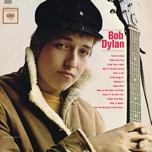 Bob Dylan is the debut studio album by American singer-songwriter Bob Dylan, released on March 19, 1962 by Columbia Records.
Bob Dylan is the debut studio album by American singer-songwriter Bob Dylan, released on March 19, 1962 by Columbia Records.
Produced by Columbia’s legendary talent scout John H. Hammond, who signed Dylan to the label, the album features folk standards, plus two original compositions, “Talkin’ New York” and “Song to Woody
Seattle World’s Fair
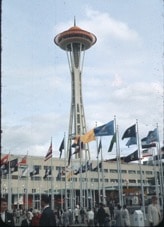
April 10, Seattle World’s Fair opened in Seattle, Washington, Century 21 Exposition. Nearly 10 million people attended the fair. Featured a Space Needle and Alweg Monorail.
Fallout Protection
Fallout Protection: What To Know And Do About Nuclear Attack was an official United States federal government booklet released in December 1961 by the United States Department of Defense and the Office of Civil Defense. The first page of the book is a note from then-U.S. Secretary of Defense Robert McNamara explaining that the booklet is the result of the first task he was given when he assumed responsibility for the Federal Civil Defense Program in August 1961. The task, assigned by President John F. Kennedy, was to “give the American people the facts they need to know about the dangers of a thermonuclear attack and what they can do to protect themselves.
Fallout Shelters
Fallout Shelters is an enclosed space specially designed to protect occupants from radioactive debris or fallout resulting from a nuclear explosion. Many such shelters were constructed as civil defense measures during the Cold War.
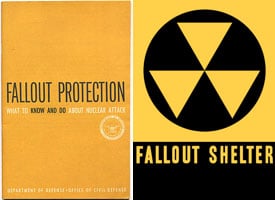 During a nuclear explosion, matter vaporized in the resulting fireball is exposed to neutrons from the explosion, absorbs them, and becomes radioactive. When this material condenses in the rain, it forms dust and light sandy materials that resemble ground pumice. The fallout emits alpha and beta particles, as well as gamma rays.
During a nuclear explosion, matter vaporized in the resulting fireball is exposed to neutrons from the explosion, absorbs them, and becomes radioactive. When this material condenses in the rain, it forms dust and light sandy materials that resemble ground pumice. The fallout emits alpha and beta particles, as well as gamma rays.
Much of this highly radioactive material falls to earth, subjecting anything within the line of sight to radiation, becoming a significant hazard. A fallout shelter is designed to allow its occupants to minimize exposure to harmful fallout until radioactivity has decayed to a safer level.
Marilyn Monroe dies
Marilyn Monroe was found dead on August 5, 1962, at her 12305 Fifth Helena Drive home in Los Angeles of a barbiturate overdose. She was a major sex symbol and one of the most popular Hollywood stars during the 1950s and early 1960s. She was a top-billed actress for a decade, and her films grossed $200 million by 1962.
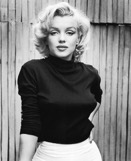 At the time of her death, Monroe had suffered from mental illness and substance abuse for several years, and had not completed a film since The Misfits, released in 1961.
At the time of her death, Monroe had suffered from mental illness and substance abuse for several years, and had not completed a film since The Misfits, released in 1961.
She had spent 1961 preoccupied with her various health problems, and in April 1962 had begun filming Something’s Got to Give for 20th Century Fox, but was fired in early June. The studio publicly blamed her for the production’s problems, and in the weeks preceding her death, Monroe attempted to repair her public image by giving several interviews to high-profile publications. She also began negotiations with Fox on being re-hired for Something’s Got to Give and for starring roles in other productions.
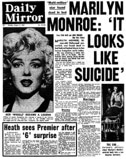 Monroe spent her last day, Saturday, August 4, at her home in Brentwood, accompanied by publicist Patricia Newcomb, housekeeper Eunice Murray, photographer Lawrence Schiller and psychiatrist Dr. Ralph Greenson at various times. At Greenson’s request, Murray stayed overnight to keep Monroe company. At approximately 3 a.m. the next day, she noticed that Monroe had locked herself in her bedroom and was unresponsive. Murray alerted Greenson, who arrived soon after and broke into the room, finding Monroe deceased. Her death was officially ruled a probable suicide by the Los Angeles County coroner’s office, based on precedents of her overdosing and being prone to mood swings and suicidal ideation. No evidence of crime was found, and accidental overdose was ruled out due to the large amount of barbiturates she had ingested. Her funeral was held on August 8 at the Westwood Village Memorial Park Cemetery, where she was interred at the Corridor of Memories.
Monroe spent her last day, Saturday, August 4, at her home in Brentwood, accompanied by publicist Patricia Newcomb, housekeeper Eunice Murray, photographer Lawrence Schiller and psychiatrist Dr. Ralph Greenson at various times. At Greenson’s request, Murray stayed overnight to keep Monroe company. At approximately 3 a.m. the next day, she noticed that Monroe had locked herself in her bedroom and was unresponsive. Murray alerted Greenson, who arrived soon after and broke into the room, finding Monroe deceased. Her death was officially ruled a probable suicide by the Los Angeles County coroner’s office, based on precedents of her overdosing and being prone to mood swings and suicidal ideation. No evidence of crime was found, and accidental overdose was ruled out due to the large amount of barbiturates she had ingested. Her funeral was held on August 8 at the Westwood Village Memorial Park Cemetery, where she was interred at the Corridor of Memories.
Despite the coroner’s verdict, several conspiracy theories suggesting murder or accidental overdose have been proposed since the mid-1960s. Many of these involve President John F. Kennedy and his brother, Robert, as well as union leader Jimmy Hoffa and mob boss Sam Giancana. Due to prevalence of these theories in the media, the office of the Los Angeles County District Attorney reviewed the case in 1982, but found no evidence to support them and did not disagree with the findings of the original investigation.
Escaped from Alcatraz
The June 1962 Alcatraz escape may have been the only successful escape from Alcatraz Federal Penitentiary in its history. Late on the night of June 11 or early morning of June 12, inmates Clarence Anglin, John Anglin, and Frank Morris tucked heads made out of soap wax resembling their own likenesses into their beds, broke out of the main prison building via an unused utility corridor, and departed Alcatraz Island aboard an improvised inflatable raft to an uncertain fate.
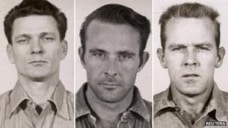 Hundreds of leads have been pursued by the FBI and local law enforcement officials in the ensuing years, but no conclusive evidence has ever surfaced favoring the success or failure of the attempt. Numerous theories of widely varying plausibility have been proposed by authorities, reporters, family members, and amateur enthusiasts. In 1979 the FBI officially concluded, on the basis of circumstantial evidence and a preponderance of expert opinion, that the men drowned in the frigid waters of San Francisco Bay before reaching the mainland. The U.S. Marshals Service case file remains open and active, however, and Morris and the Anglin brothers remain on its wanted list.
Hundreds of leads have been pursued by the FBI and local law enforcement officials in the ensuing years, but no conclusive evidence has ever surfaced favoring the success or failure of the attempt. Numerous theories of widely varying plausibility have been proposed by authorities, reporters, family members, and amateur enthusiasts. In 1979 the FBI officially concluded, on the basis of circumstantial evidence and a preponderance of expert opinion, that the men drowned in the frigid waters of San Francisco Bay before reaching the mainland. The U.S. Marshals Service case file remains open and active, however, and Morris and the Anglin brothers remain on its wanted list.
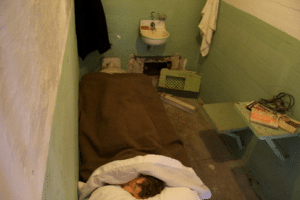 Recent experimental and computer-simulated evidence has suggested that the ultimate outcome of the attempt may have depended on the exact time of the men’s departure aboard the raft.
Recent experimental and computer-simulated evidence has suggested that the ultimate outcome of the attempt may have depended on the exact time of the men’s departure aboard the raft.
A 2015 documentary presented circumstantial evidence in support of a longstanding rumor that two of the men – the Anglin brothers – had survived and fled to Brazil; but a government expert concluded that the one piece of physical evidence, a 1975 photograph, did not support that conclusion.
Rachel Carson: Silent Spring
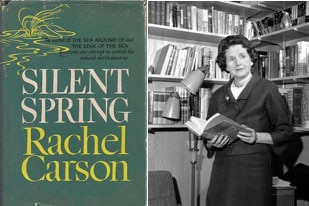
Telstar
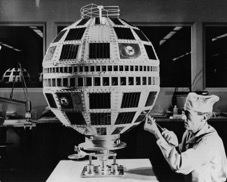 Telstar is the name of various communications satellites. The first two Telstar satellites were experimental and nearly identical.
Telstar is the name of various communications satellites. The first two Telstar satellites were experimental and nearly identical.
Telstar 1 launched on top of a Thor-Delta rocket on July 10, 1962. It successfully relayed through space the first television pictures, telephone calls, and telegraph images, and provided the first live transatlantic television feed.
Telstar 2 launched May 7, 1963. Telstar 1 and 2—though no longer functional—still orbit the Earth.
Andy Warhol
Introduced 32 paintings of Campbell’s soup cans at Ferus Gallery in West Hollywood, California, in Los Angeles. His works explore the relationship between artistic expression, celebrity culture, and advertising which flourished in the 1960s.
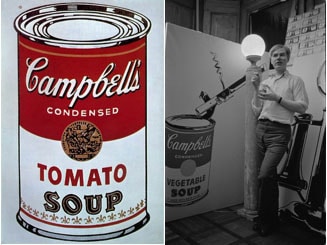
Beatles
After the Beatles completed their second Hamburg residency, they enjoyed increasing popularity in Liverpool with the growing Merseybeat movement. However, they were also growing tired of the monotony of numerous appearances at the same clubs night after night. In November 1961, during one of the group’s frequent performances at The Cavern Club, they encountered Brian Epstein, a local record-store owner and music columnist. He later recalled: “I immediately liked what I heard. They were fresh, and they were honest, and they had what I thought was a sort of presence … [a] star quality.” Epstein courted the band over the next couple of months, and they appointed him as their manager in January 1962.
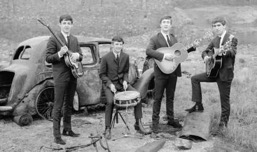 Throughout early and mid-1962, Epstein sought to free the Beatles from their contractual obligations to Bert Kaempfert Productions. He eventually negotiated a one-month-early release from their contract in exchange for one last recording session in Hamburg. Tragedy greeted them on their return to Germany in April, when a distraught Kirchherr met them at the airport with news of Sutcliffe’s death the previous day from what would later be determined to have been a brain hemorrhage. Epstein began negotiations with record labels for a recording contract. In order to secure a UK record contract, Epstein negotiated an early end to the band’s contract with Polydor, in exchange for more recordings backing Tony Sheridan. After a New Year’s Day audition, Decca Records rejected the band with the comment “Guitar groups are on the way out, Mr. Epstein.” However, three months later, producer George Martin signed the Beatles to EMI’s Parlophone label.
Throughout early and mid-1962, Epstein sought to free the Beatles from their contractual obligations to Bert Kaempfert Productions. He eventually negotiated a one-month-early release from their contract in exchange for one last recording session in Hamburg. Tragedy greeted them on their return to Germany in April, when a distraught Kirchherr met them at the airport with news of Sutcliffe’s death the previous day from what would later be determined to have been a brain hemorrhage. Epstein began negotiations with record labels for a recording contract. In order to secure a UK record contract, Epstein negotiated an early end to the band’s contract with Polydor, in exchange for more recordings backing Tony Sheridan. After a New Year’s Day audition, Decca Records rejected the band with the comment “Guitar groups are on the way out, Mr. Epstein.” However, three months later, producer George Martin signed the Beatles to EMI’s Parlophone label.
Martin’s first recording session with the Beatles took place at EMI’s Abbey Road Studios in London on 6 June 1962. Martin immediately complained to Epstein about Best’s poor drumming and suggested they use a session drummer in his place.[38] Already contemplating Best’s dismissal, the Beatles replaced him in mid-August with Ringo Starr, who left Rory Storm and the Hurricanes to join them. A 4 September session at EMI yielded a recording of “Love Me Do” featuring Starr on drums, but a dissatisfied Martin hired drummer Andy White for the band’s third session a week later, which produced recordings of “Love Me Do”, “Please Please Me” and “P.S. I Love You”. Martin initially selected the Starr version of “Love Me Do” for the band’s first single, though subsequent re-pressings featured the White version, with Starr on tambourine. Released in early October, “Love Me Do” peaked at number seventeen on the Record Retailer chart. Their television debut came later that month with a live performance on the regional news programme People and Places. After Martin suggested rerecording “Please Please Me” at a faster tempo, a studio session in late November yielded that recording, of which Martin accurately predicted, “You’ve just made your first No.1.”
In December 1962, the Beatles concluded their fifth and final Hamburg residency. By 1963, they had agreed that all four band members would contribute vocals to their albums – including Starr, despite his restricted vocal range, to validate his standing in the group.[46] Lennon and McCartney had established a songwriting partnership, and as the band’s success grew, their dominant collaboration limited Harrison’s opportunities as a lead vocalist. Epstein, in an effort to maximise the Beatles’ commercial potential, encouraged them to adopt a professional approach to performing. Lennon recalled him saying, “Look, if you really want to get in these bigger places, you’re going to have to change – stop eating on stage, stop swearing, stop smoking …” Lennon said: “We used to dress how we liked, on and off stage. He’d tell us that jeans were not particularly smart and could we possibly manage to wear proper trousers, but he didn’t want us suddenly looking square. He’d let us have our own sense of individuality.”
James Meredith enrolls at University of Mississippi
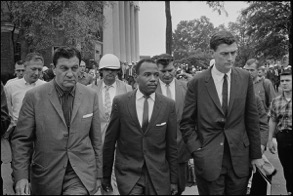 The Ole Miss riot of 1962, or Battle of Oxford, was fought between Southern segregationist civilians and federal and state forces beginning the night of September 30, 1962; segregationists were protesting the enrollment of James Meredith, a black US military veteran, at the University of Mississippi (known affectionately as Ole Miss) at Oxford, Mississippi.
The Ole Miss riot of 1962, or Battle of Oxford, was fought between Southern segregationist civilians and federal and state forces beginning the night of September 30, 1962; segregationists were protesting the enrollment of James Meredith, a black US military veteran, at the University of Mississippi (known affectionately as Ole Miss) at Oxford, Mississippi.
Two civilians were killed during the night, including a French journalist, and over 300 people were injured,including one third of the US Marshals deployed.
Cuban Missile Crisis
Cuban Missile Crisis was a 13-day (October 16–28, 1962) confrontation between the United States and the Soviet Union concerning American ballistic missile deployment in Italy and Turkey with consequent Soviet ballistic missile deployment in Cuba. The confrontation is often considered the closest the Cold War came to escalating into a full-scale nuclear war.
In response to the failed Bay of Pigs Invasion of 1961 and the presence of American Jupiter ballistic missiles in Italy and Turkey, Soviet leader Nikita Khrushchev decided to agree to Cuba’s request to place nuclear missiles on the island to deter a future invasion. An agreement was reached during a secret meeting between Khrushchev and Fidel Castro in July 1962 and construction of a number of missile launch facilities started later that summer.
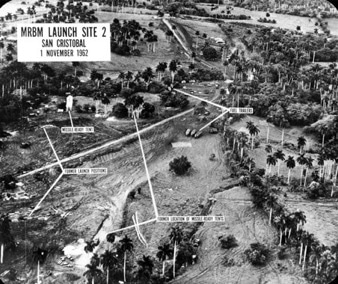 The 1962 United States elections were under way, and the White House had denied charges that it was ignoring dangerous Soviet missiles 90 miles from Florida. The missile preparations were confirmed when an Air Force U-2 spy plane produced clear photographic evidence of medium-range (SS-4) and intermediate-range (R-14) ballistic missile facilities. The US established a military blockade to prevent further missiles from reaching Cuba; Oval Office tapes during the crisis revealed that Kennedy had also put the blockade in place as an attempt to provoke Soviet-backed forces in Berlin as well. It announced that they would not permit offensive weapons to be delivered to Cuba and demanded that the weapons already in Cuba be dismantled and returned to the Soviet Union.
The 1962 United States elections were under way, and the White House had denied charges that it was ignoring dangerous Soviet missiles 90 miles from Florida. The missile preparations were confirmed when an Air Force U-2 spy plane produced clear photographic evidence of medium-range (SS-4) and intermediate-range (R-14) ballistic missile facilities. The US established a military blockade to prevent further missiles from reaching Cuba; Oval Office tapes during the crisis revealed that Kennedy had also put the blockade in place as an attempt to provoke Soviet-backed forces in Berlin as well. It announced that they would not permit offensive weapons to be delivered to Cuba and demanded that the weapons already in Cuba be dismantled and returned to the Soviet Union.
After a long period of tense negotiations, an agreement was reached between US President John F. Kennedy and Khrushchev. Publicly, the Soviets would dismantle their offensive weapons in Cuba and return them to the Soviet Union, subject to United Nations verification, in exchange for a US public declaration and agreement to avoid invading Cuba again. Secretly, the United States also agreed that it would dismantle all U.S.-built Jupiter MRBMs, which had been deployed in Turkey against the Soviet Union; there has been debate on whether or not Italy was included in the agreement as well.
When all offensive missiles and Ilyushin Il-28 light bombers had been withdrawn from Cuba, the blockade was formally ended on November 21, 1962. The negotiations between the United States and the Soviet Union pointed out the necessity of a quick, clear, and direct communication line between Washington and Moscow. As a result, the Moscow–Washington hotline was established. A series of agreements reduced US-Soviet tensions for several years.
